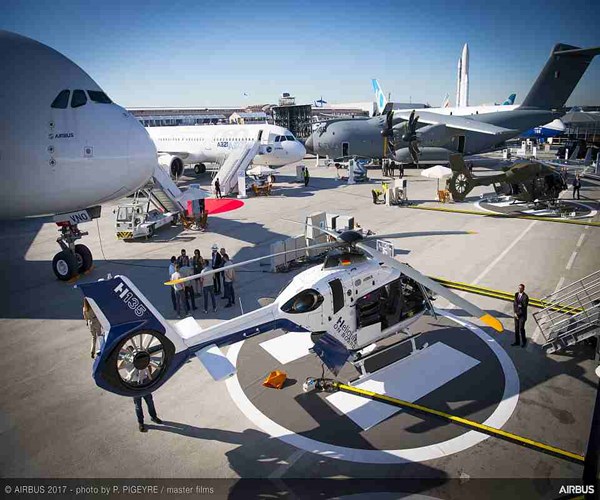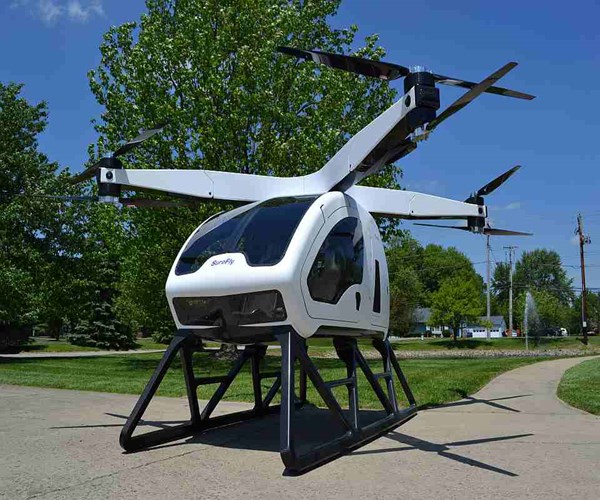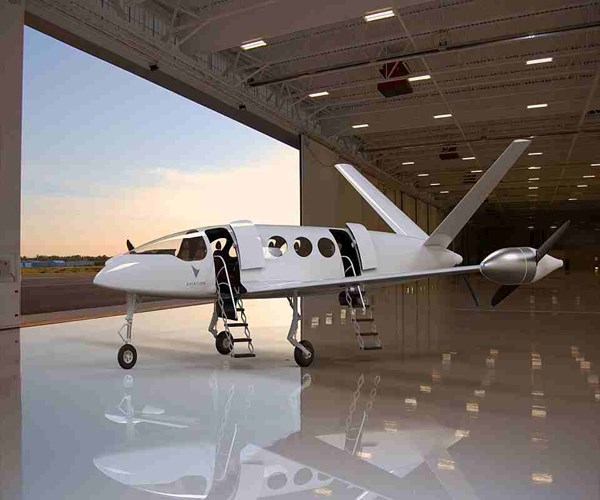2017 Paris Air Show is good for composites
There is definitely a lot going on this week at the Paris Air Show at Le Bourget airfield. Much of it relates to composites. Here’s a brief rundown.

2017 is the 52nd edition of the Paris Air Show. Boeing unveiled its new 737 MAX 10 aircraft and talked about the New Midsize Airplane (NMA), while Airbus discussed the A380plus.
There is definitely a lot going on this week at the Paris Air Show at Le Bourget airfield. Much of it relates to composites. Here’s a brief rundown of what I’ve found, so far, and I’ll add to this blog as I learn new information.
The 52nd edition of the Paris Air Show had everything from industry-related announcements, new aircraft, redesigned aircraft and material/process innovations. On the event’s first day, June 19, The Boeing Co. (Chicago, IL, US) announced the launch of the 737 MAX 10 as the newest member of the 737 MAX family, 66 inches longer than the MAX 9 and reportedly providing the lowest seat-mile cost of any single-aisle airplane ever produced. According to Boeing, the aircraft has gained wide market acceptance with more than 240 orders and commitments secured from more than 10 customers worldwide. Customers order details were announced throughout the week, including CDB Aviation Lease Finance’s (CDB Aviation) signing of a Memorandum of Understanding (MOU) for 52 737s and eight (8) 787-9 Dreamliners, a commitment valued at $7.4 billion at list prices.
Regarding Boeing’s projected New Midsize Airplane, still many years away, the company did confirm to Aviation Week’s ShowNews that the new craft will involve both composite wings and a composite fuselage. According to the published story, the fuselage tube will be a “hybrid” composite with an “unusual” cross-sectional shape, not circular and not ovoid. CW is following this story and definitely will keep readers posted.

Airbus' static display.
Airbus announced that it has completed a development study for an enhanced A380, to be called the “A380plus,” that will include aero improvements including larger winglets and other wing enhancements for better fuel burn. The company claims that the changes will provide an overall benefit of 13% reduction in cost per seat compared to the present A380. Also announced on the show’s first day was that GE Capital Aviation Services (GECAS), the commercial aircraft leasing and financing arm of General Electric, has signed a firm order for 100 A320neo aircraft. GECAS has selected CFM’s LEAP-1A engine for all the planes in that order.
Solvay Composite Materials (Brussels, Belgium), which includes Cytec Solvay Group (Woodland Park, NJ, US) and GKN Aerospace’s (Redditch, UK) Fokker business (Papendrecht, Netherlands) announced they have teamed up to promote and accelerate the adoption of thermoplastic composite materials on aircraft, with Solvay becoming a preferred supplier of these innovative lightweight materials to Fokker. Under the agreement, Solvay and GKN Aerospace’s Fokker business will combine their expertise to advance technological developments in thermoplastic composite materials, as well as improve processes and cost competitiveness. The businesses have complementary materials expertise in thermoplastic polymers and fiber reinforced composites. GKN Aerospace’s Fokker business also brings leadership in component design and manufacturing, to translate the technology into innovative solutions for aerospace customers.
“Solvay’s partnership with GKN Aerospace’s Fokker business is an important step in our goal to become the leading supplier of thermoplastic composite materials to the aerospace, oil & gas and automotive industries. A deeper understanding of the market’s needs and challenges in adopting these new materials together with Fokker’s expertise in design and manufacturing will enable us to develop technologies to industrialize the manufacturing of thermoplastic composites and parts,” says Carmelo Lo Faro, president of Solvay’s Composite Materials Global Business Unit (GBU).
The F-35 Joint Strike Fighter Lightning II made its first-ever appearance at the show, and put on an aerial demonstration designed to silence critics and disprove what Lockheed Martin’s (Bethesda, MD, US) test pilot Billie Flynn called “years of misinformation” about the plane’s capabilities. Lockheed Martin executive Jeff Babione told the press at Le Bourget that his company is close to a deal worth nearly $40 billion USD to supply jets to the US and allied nations over the next several years, more than doubling the total number of planes currently under contract.
In another first, Mitsubishi Aircraft Corp.’s (Nagoya, Japan) MRJ regional jet was on static display at the show, with the craft’s sharply-pointed aerodynamic nose attracting attention. The single-aisle regional jet made its first trip to Europe from the company’s flight test center located in Moses Lake, WA, US. Equipped with Pratt & Whitney (East Hartford, CN, US) geared turbofan engines, the aircraft has accomplished many of its scheduled testing milestones on the way to full certification. The company says the MRJ uses 20% less fuel than competitors, thanks to its aero design and the P&W engines. First delivery is scheduled for mid-2020.
MTorres (Torres de Elorz, Navarra, Spain) is exhibiting its revolutionary new composite fuselalge and wing manufacturing concept (Hall 1 Stand G318) as CW has previously reported (http://www.compositesworld.com/news/revolutionary-fuselage-concept-unveiled-by-mtorres ). The concept apparently may involve producing C-frames or ring frames in a separate process, with frames held together to create an outer mold line (OML) surface, over which the fuselage skin is fiber placed using MTorres’ fiber placement head and dry carbon fiber tape. The frames are reportedly integrated into the fuselage. The structure is then infused, says MTorres, and oven cured. The company says that the "final phase" of the material used in production, possibly the dry tape itself, is made by MTorres, which could reduce raw material cost by up to 50%, according to published reports. By eliminating rivets, fuselage weight can be reduced by 10% to 30%, said MTorres before the show, and tooling costs as well as labor costs would be significantly reduced. Spanish press reports quote MTorres as saying that 6,000 hours of work were saved with this new fabrication concept, compared to existing methods.
Airbus Helicopters announced at the show that autonomous flight trials of its VSR700 Optionally Piloted Vehicle (OPV) demonstrator have begun, with a safety pilot on board, paving the way for a first flight of the actual VSR700 prototype in 2018. Developed as a light military rotary wing tactical unmanned aerial vehicle with a low-fuel-consumption diesel engine, the craft is being developed jointly by Airbus Helicopters and Helicopteres Guimbal (Aix-in-Provence, France), the original manufacturer of the civil Cabri G2, from which the VSR700 is derived. Airbus says the autonomous helicopter was developed to meet naval requirements for a cost-effective shipborne tactical aerial vehicle to carry out surveillance and reconnaissance missions.

SureFly helicopter
Another autonomous helicopter debut came from Workhorse Group Inc. (Loveland, OH, US), maker of the HorseFly package delivery drone that has been tested by United Parcel Service (UPS). The larger SureFly helicopter concept is designed for short hops, aimed at commercial transportation, emergency responders, the military and even city commuters. Called a “personal helicopter/VTOL aircraft” by the company, it is a two-seat hybrid-electric vertical takeoff and landing craft designed to be safer and more stable than typical helicopters thanks to its redundant design. Its four arms atop the cabin are each equipped with two contra-rotating propellers powered by electric motors, with a backup battery system to drive the motors in the event of failure of the gas combustion engine; in an emergency, a ballistic parachute can be deployed. It is designed to be easy to pilot, and capable of carrying pilot and passenger or cargo up to 70 miles. Early models will be pilot-operated, says Workhorse, with flight tests scheduled for this year, but the goal is to eventually introduce autonomous versions capable of carrying payloads up to 182 kg. The fuselage, propeller arms and propellers themselves are fabricated with carbon fiber composites.

EViation electric all-composite aircraft.
A new all-electric, all-composite aircraft from startup EViation (Qadima-Tzoran, Israel) made its first appearance, with company founder Omer Bar-Yohai stating “Transportation as we know it is set to change. The dominant solutions available today are deeply flawed and demand disruption.” EViation believes it can offer high-speed, sustainable and convenient regional commuting using light aircraft, tightly integrated with on-demand ground transport solutions. Currently, a sub-scale prototype is undergoing testing and risk-reduction evaluations. The company expects its first firm orders from its lead customer next year, says Bar-Yohai.
Three designs are in development. Alice, able to carry 9 passengers, will be optimized as an air taxi, with a proposed cost of $1.4 million USD. Alice ER is a 6-passenger, pressurized luxury version positioned to compete with existing business jets. Orca is an unmanned variant, with very short takeoff and landing (VSTOL) characteristics and long-duration capability. The aircrafts’ all-composite designs and efficient aerodynamics, combined with compact energy storage using high-energy-density batteries, will be built to fit into the regulatory environment, says Bar-Yohai, including the US Federal Aviation Admin. (FAA) electric aviation committees: “With this aircraft, air taxi operators will be able to give customers on-demand travel [to] the nearest landing strip for the price of a train ticket.” EViation partnered with established manufacturers for production and certification risk sharing, including Magnaghi Aeronautica SpA (Napoli,Italy), the manufacturer of the SkyAero aircraft, and FBM (Kiryat Gat, Israel), a producer of carbon-based composites, which manufactured the all-composite prototypes.
Textron Systems (Providence, RI, US) unveiled a new tactical unmanned aircraft system (UAS) called NightWarden, which builds upon and improves the company’s developmental Shadow M2 UAS, says Textron. With a range of 1100 km and 15 hours of endurance, the new UAS has a payload capacity of up to 59 kg and can be configured in multiple ways, including carrying munitions.
Related Content
Combining multifunctional thermoplastic composites, additive manufacturing for next-gen airframe structures
The DOMMINIO project combines AFP with 3D printed gyroid cores, embedded SHM sensors and smart materials for induction-driven disassembly of parts at end of life.
Read MorePlant tour: Joby Aviation, Marina, Calif., U.S.
As the advanced air mobility market begins to take shape, market leader Joby Aviation works to industrialize composites manufacturing for its first-generation, composites-intensive, all-electric air taxi.
Read MoreManufacturing the MFFD thermoplastic composite fuselage
Demonstrator’s upper, lower shells and assembly prove materials and new processes for lighter, cheaper and more sustainable high-rate future aircraft.
Read MoreWelding is not bonding
Discussion of the issues in our understanding of thermoplastic composite welded structures and certification of the latest materials and welding technologies for future airframes.
Read MoreRead Next
“Structured air” TPS safeguards composite structures
Powered by an 85% air/15% pure polyimide aerogel, Blueshift’s novel material system protects structures during transient thermal events from -200°C to beyond 2400°C for rockets, battery boxes and more.
Read MorePlant tour: Daher Shap’in TechCenter and composites production plant, Saint-Aignan-de-Grandlieu, France
Co-located R&D and production advance OOA thermosets, thermoplastics, welding, recycling and digital technologies for faster processing and certification of lighter, more sustainable composites.
Read MoreDeveloping bonded composite repair for ships, offshore units
Bureau Veritas and industry partners issue guidelines and pave the way for certification via StrengthBond Offshore project.
Read More



















